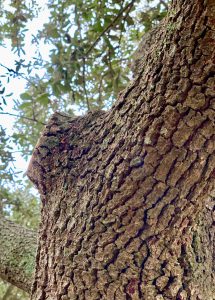
Nuckols Tree Care came by to cut back the jungle in my yard this week.
I have a love-hate relationship with the wild hedgerow between me and my neighbor. It is on the land side of an old secondary dune and so many bushes, trees and vines, some natives and some not, have grown up there, literally, since man first settled at the beach.
Taming it completely would be impossible without risking the sand dune simply eroding into my yard, but Nuckols manages to protect the good trees and cut back the bad ones and slow down the greenbriar, trumpet vine, even English ivy, from overtaking me.
At the same time, Nuckols gave a little tune-up to the healthy trees around the yard. Nate Jones, an arborist with Nuckols, is very careful about how he goes about pruning a healthy tree. So, I asked for any advice he might have for the do-it-yourselfer, who has trees in need of a haircut, whether for the tree’s health or because the tree branches might be a hazard.
Nate recommended that if you are planning anything extensive to call an arborist for a consultation. That way you pay a fee for an arborist’s advice, but you are not paying for a whole crew of men and equipment.
Either way, here are some of Nate’s tip that he says you should read up on before you set out with your loppers and tree saw.
Prune out the dead branches and the cross branches.
Prune back only to the branch collar. That’s the enlarged area where a branch grows from its mother branch or from the tree trunk.

If you aren’t sure exactly where the collar is, it’s best to leave a stub, rather than prune beyond the collar.
If you prune beyond the collar your tree will send forth multiple spindly branches. That’s what happens when someone commits crape murder on their crape myrtle tree.
One of Nate’s personal tricks is to always start out cutting small rather than big, because, he said, you can always cut more. “I prune in circles,” Nate added. “I might go around the tree two to three times to make sure I get it right.”
I watched him go round and round under my little live oak, making sure the branches wouldn’t grow into my house or the next door neighbor’s shed as he tried to leave the tree with as many live branches as possible. It was almost as if Nate didn’t want the tree to say, “Ouch!”
If you decide to prune on your own, here’s a publication that explains the tree collar in depth and more from Virginia Tech, “A Guide to Successful Pruning: Pruning Basics and Tools,” https://www.pubs.ext.vt.edu/430/430-455/430-455.html. One of the co-authors is Susan French, now the Virginia Beach City Arborist.
Whatever you do, take care with your trees and listen for the “Ouch!!”